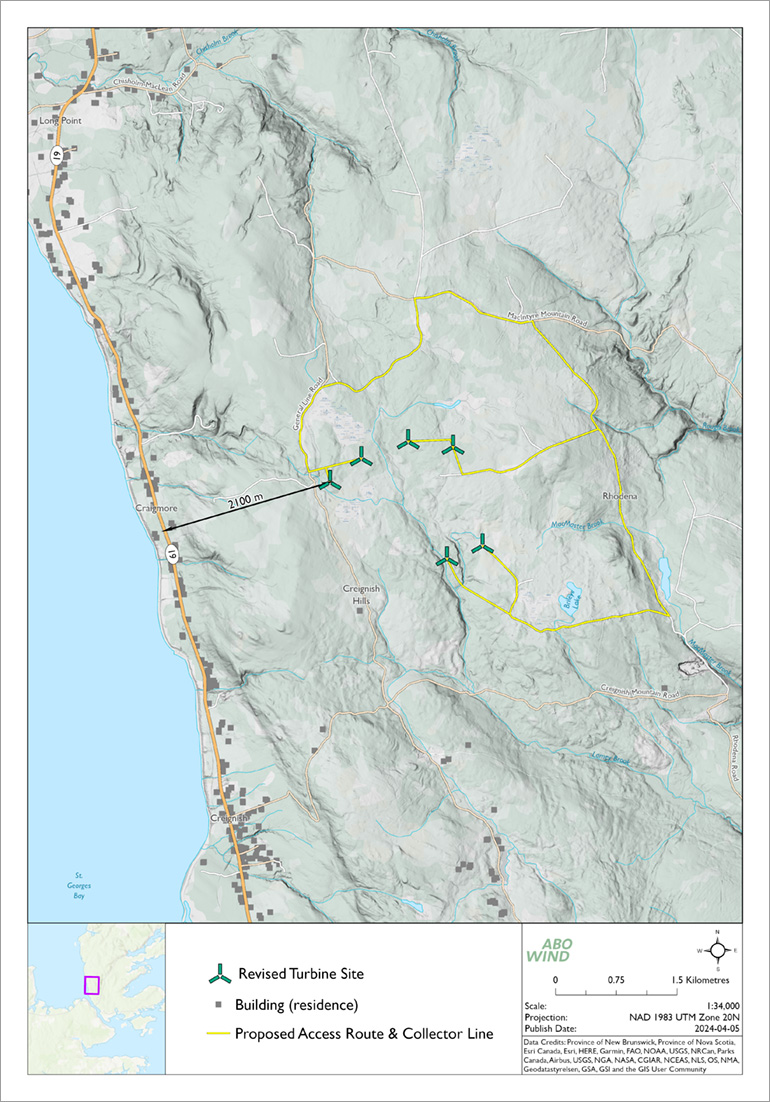January 27, 2025: Rhodena Wind Project Successful in Green Choice Program
ABO Energy Canada Ltd., and our valued project partners; Eskasoni First Nation, Potlotek First Nation, Wagmatcook First Nation, and We’koqma’q L’nue’kati, have learned the Rhodena Wind Project was successful in response to the Nova Scotia Green Choice Program Request for Proposals (RFP).
The Project recently achieved a significant milestone with an Environmental Assessment approval on January 6, 2025.
The Project team looks forward to sharing updates with you regarding the next steps for Rhodena Wind including timelines, additional engagement, and upcoming local opportunities. Our Project website will continue to be updated with new information as development progresses (www.rhodenawind.ca).
View the Province of Nova Scotia’s press release on the announcement here: Green Choice Program Greening the Grid, Creating Jobs, Improving Energy Independence | Government of Nova Scotia News Releases
November 2024:
Rhodena Wind Update and Environmental Assessment Registration
The ABO Energy team was pleased to submit our application for the Rhodena Wind Project to the Green Choice Program Administrator (Coho) in June 2024, as previously communicated. The Green Choice portfolio announcement is expected within the coming months. Another significant milestone has been reached for our Project development – we registered our Environmental Assessment for the Rhodena Wind Project with the Province of Nova Scotia on November 6, 2024.
If successful in both the Green Choice Program and the Environmental Assessment (EA) process, ABO Energy intends to begin construction between late 2025 and mid-2026. ABO Energy has been working with a local environmental consultant for the past few years to complete thorough field and desktop studies of environmental features in the proposed Project area to support the EA. We also use this information to understand areas to avoid completely or plan for potential mitigations to reduce impact.
The EA is available for public review and comment as of November 6, 2024. The public comment period is open for a period of 30 days. The EA document is available online for review here. It is also available to review in-person in the local area at the Municipality of Inverness County Municipal Administrative Office and the Port Hawkesbury Public Library during this period. Members of the public are encouraged to review the document and provide feedback for the Province to review by emailing EA@novascotia.ca or mailing the feedback to Environmental Assessment Branch, Nova Scotia Environment & Climate Change, P.O. Box 442, Halifax, Nova Scotia B3J 2P8. A notice of the EA and public comment period opportunity has also been advertised in the Inverness Oran and Chronicle Herald.
You can learn more about the Environmental Assessment process here.
August 2024: Green Choice Program Revised Project Award Timeline
The ABO Energy team was pleased to submit our application for this Project to the Green Choice Program Administrator (Coho) per their deadline of June 28, 2024. The Green Choice Program award was initially scheduled for mid-September; however, the Program Administrator has since shared publicly that the Green Choice portfolio decision will be announced on November 8, 2024. In the meantime, our team will be continuing our studies and planning efforts for this Project, in addition to ongoing local engagement. We will continue to share any key updates with members of the public. In the meantime, we always welcome any questions or feedback – reach out to heidi.kirby@aboenergy.com.
April 2024: Information Sessions
Thank you to all who came out to attend the July 2023 Rhodena Wind information sessions, hosted by the ABO Wind Canada team in Creignish. We value your feedback and local knowledge, and remain committed to transparent, meaningful, and ongoing community and stakeholder engagement.
ABO Wind will be hosting two additional information sessions to discuss important 2024 updates for the Rhodena Project with you:
Wednesday, April 17 2024
Afternoon drop-in session: 2pm – 4:30pm
Evening drop-in session: 6pm - 8:30pm
Creignish Recreation Centre
2123 Route 19, Creignish
We are glad that you are visiting our website. We hope to answer any questions that you may have and encourage you to get in touch. If you have questions about the project, please contact Heidi Kirby of ABO Wind.
Please find the Open House Posters from the April Sessions here.
February 2024: Update
Now, up to 6 wind turbines would be placed on the hills between Route 19 and Trans-Canada Highway 105 in the Municipality of the County of Inverness on private land where we have the permission of the landowner. This renewable energy project would produce an estimated 42 megawatts of green energy – enough to power more than 13,600 homes annually!
Why the change from 15 turbines to 6?
The Green Choice program has a new requirement to build on private land only, so we are no longer utilizing Crown lands for our turbines. We are hopeful this new layout, with a reduced footprint and only 6 turbines, is accepted positively by the community. We look forward to hearing your feedback as we prepare to submit our Project into this procurement round in June 2024.
Additional environmental studies are ongoing to help inform ABO Wind’s Environmental Assessment, a required component to proceed with Project construction.
New Map: Rhodena Wind
6 turbines, producing 42 megawatts of clean energy
The new layout is expected to use nearly 70% already existing roads, with about 10% of these requiring upgrades to ensure safe access and sufficient widening for equipment association with wind turbine installation. With our new 6-turbine layout, we have reduced the amount of expected land disturbance caused by site preparation and construction by nearly 50 ha (from 155 ha to 107 ha).
We also are still inviting interested individuals to join the Rhodena Wind Community Liaison Committee (CLC). CLC Members will meet periodically and will have a regular opportunity to share input, guidance, community views, and concerns to help inform the Project plan and related activities.
ABO Wind strongly encourages the public to participate in the Project planning process, issue identification, and problem solving.
Do you have general Project questions, or interest in joining the CLC? Please reach out to Heidi Kirby.
June 2023: Update
ABO Wind is conducting public engagement during the summer and fall as we prepare to submit the Rhodena Wind Project for Nova Scotia’s Green Choice Program later this year. Updates on the Project will be shared on this website.
We are mailing an update to households in communities close to the project.
July 15, 2022: Project Announcement
ABO Wind has received word that the Rhodena Wind Project was not selected for the short list of the Nova Scotia Rate Based Procurement. Although we are disappointed with the outcome, ABO Wind will continue with the planning and design of the project, which will be further refined through ongoing environmental and technical information as well as stakeholder feedback, in preparation for the next Provincial opportunity. If you have questions about the project, please contact David Berrade of ABO Wind at dave.berrade@abo-wind.com or by phone at 902-802-4540.
May 2022: Project Update
We are mailing an update to households in communities close to the project.
Download the pamphlet
March 2022: Project Update
We are mailing an update to households in communities close to the project, with a new map of the proposed development area.
Download the pamphlet
September 2021: Open House on September 14, 2021
Please join us at the Open House to learn more about the proposed Rhodena Wind Project:
Tuesday, September 14, 7 pm to 9 pm
Port Hastings Fire Hall,
15 Old Victoria Road
Meet the partners – Nova Scotia company Community Wind and international renewable energy experts ABO Wind Canada. Learn more about the construction schedule and process, how the turbines will look and sound, and about environmental studies underway. Hear about opportunities and provide your input on how to use a community benefit fund from the project.





















